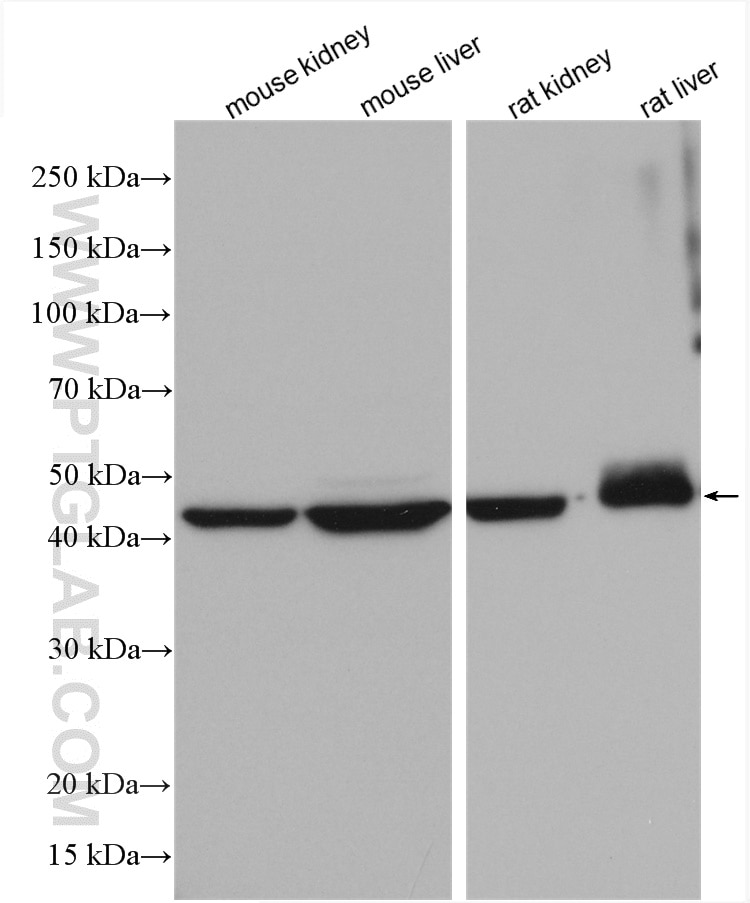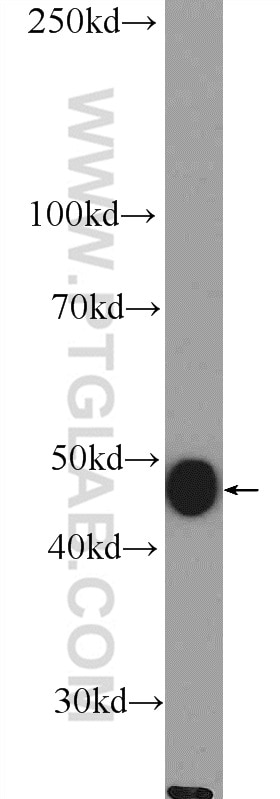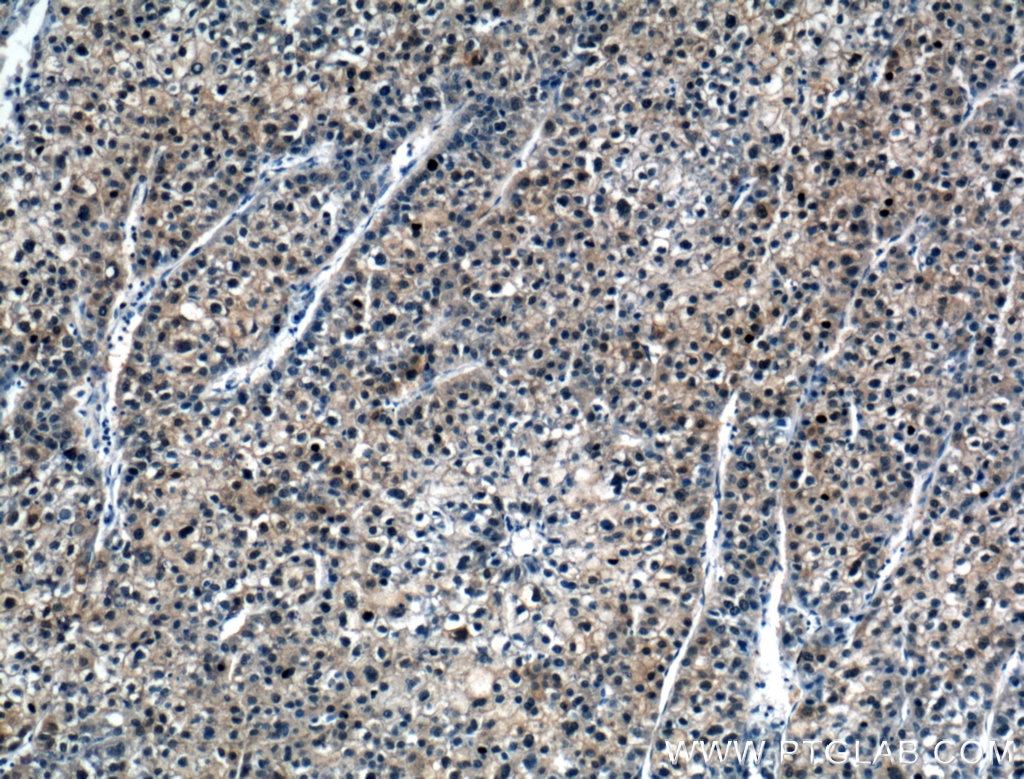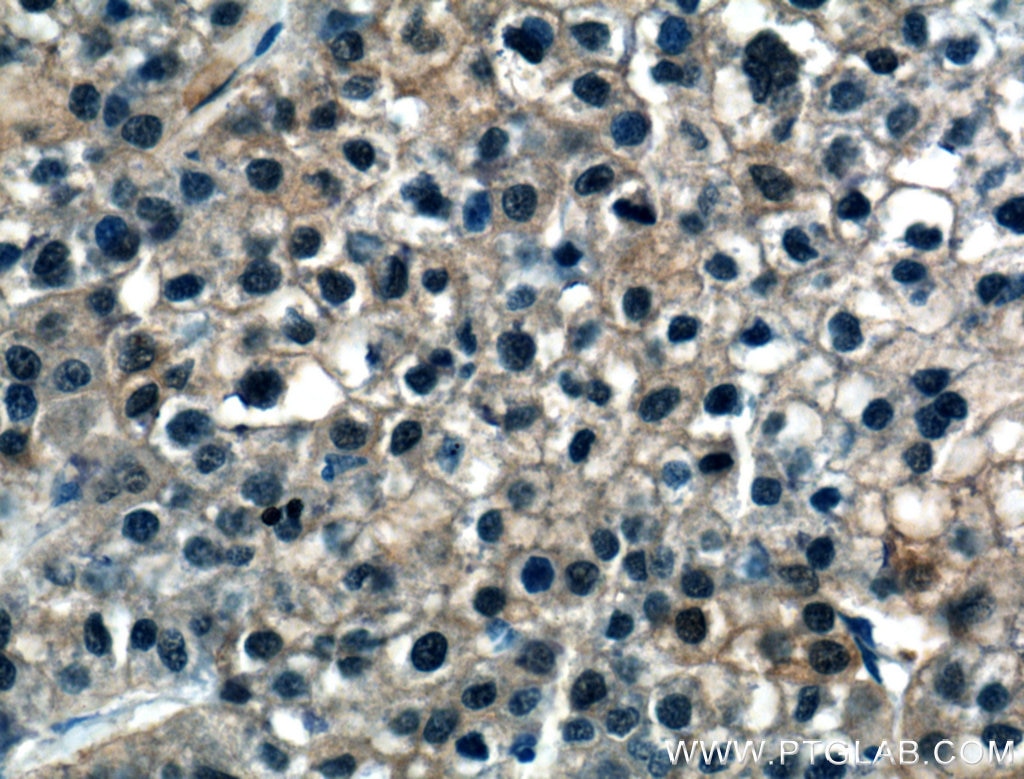Anticorps Polyclonal de lapin anti-ASL
ASL Polyclonal Antibody for WB, IHC, ELISA
Hôte / Isotype
Lapin / IgG
Réactivité testée
Humain, rat, souris
Applications
WB, IHC, ELISA
Conjugaison
Non conjugué
N° de cat : 16645-1-AP
Synonymes
Galerie de données de validation
Applications testées
| Résultats positifs en WB | tissu rénal de souris, tissu hépatique de rat, tissu hépatique de souris, tissu rénal de rat |
| Résultats positifs en IHC | tissu de cancer du foie humain il est suggéré de démasquer l'antigène avec un tampon de TE buffer pH 9.0; (*) À défaut, 'le démasquage de l'antigène peut être 'effectué avec un tampon citrate pH 6,0. |
Dilution recommandée
| Application | Dilution |
|---|---|
| Western Blot (WB) | WB : 1:1000-1:6000 |
| Immunohistochimie (IHC) | IHC : 1:100-1:400 |
| It is recommended that this reagent should be titrated in each testing system to obtain optimal results. | |
| Sample-dependent, check data in validation data gallery | |
Applications publiées
| WB | See 7 publications below |
| IHC | See 1 publications below |
Informations sur le produit
16645-1-AP cible ASL dans les applications de WB, IHC, ELISA et montre une réactivité avec des échantillons Humain, rat, souris
| Réactivité | Humain, rat, souris |
| Réactivité citée | Humain, souris |
| Hôte / Isotype | Lapin / IgG |
| Clonalité | Polyclonal |
| Type | Anticorps |
| Immunogène | ASL Protéine recombinante Ag10007 |
| Nom complet | argininosuccinate lyase |
| Masse moléculaire calculée | 55 kDa |
| Poids moléculaire observé | 49 kDa |
| Numéro d’acquisition GenBank | BC008195 |
| Symbole du gène | ASL |
| Identification du gène (NCBI) | 435 |
| Conjugaison | Non conjugué |
| Forme | Liquide |
| Méthode de purification | Purification par affinité contre l'antigène |
| Tampon de stockage | PBS with 0.02% sodium azide and 50% glycerol |
| Conditions de stockage | Stocker à -20°C. Stable pendant un an après l'expédition. L'aliquotage n'est pas nécessaire pour le stockage à -20oC Les 20ul contiennent 0,1% de BSA. |
Informations générales
Argininosuccinate lyase (ASL), one of the significant UC enzymes, catalyzes argininosuccinate cleavage to generate arginine and fumarate. Arginine is then catalyzed by arginase to ornithine and polyamines, which are found to promote cancer cell proliferation and growth. Importantly, ASL ectopic expression is closely associated with poor prognosis of colorectal cancer, hepatocellular. ASL is a member of the aspartase/fumarase superfamily. Enzymes of this superfamily share similar tetrameric structure and active site, though the sequence identities between different members are quite low (less than 20%). Members of this superfamily have been recognised as drug targets for microbial infections. ASL is a 464-amino-acid enzyme with a molecular mass of 49.7 kDa. (PMID: 22386318 PMID: 31018905)
Protocole
| Product Specific Protocols | |
|---|---|
| WB protocol for ASL antibody 16645-1-AP | Download protocol |
| IHC protocol for ASL antibody 16645-1-AP | Download protocol |
| Standard Protocols | |
|---|---|
| Click here to view our Standard Protocols |
Publications
| Species | Application | Title |
|---|---|---|
Cell Metab Lighting up arginine metabolism reveals its functional diversity in physiology and pathology | ||
Mol Metab SWI/SNF complex subunit BAF60a represses hepatic ureagenesis through a crosstalk between YB-1 and PGC-1α. | ||
Cell Discov TET2 is required to suppress mTORC1 signaling through urea cycle with therapeutic potential | ||
Sci Transl Med Aberrant methylmalonylation underlies methylmalonic acidemia and is attenuated by an engineered sirtuin | ||
ACS Nano Microneedles Loaded with Nitric-Oxide Driven Nanomotors Improve Force-Induced Efferocytosis Impairment and Sterile Inflammation by Revitalizing Macrophage Energy Metabolism | ||
Phytomedicine Crataegus pinnatifida polysaccharide alleviates DSS-induced colitis in mice by regulating the intestinal microbiota and enhancing arginine biosynthesis |





